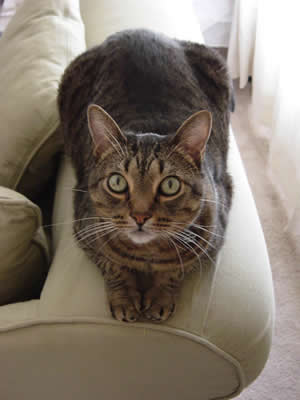Breed Standard
Head: Sculpted, of medium length and width. Rounded skull. Slightly domed forehead. Slight nose break. Prominent cheekbones. Full, well-developed muzzle of medium length. Strong chin. Powerfully developed jaws.
Eyes: Almond-shaped, well-open, set at a slight slant and well apart. Color: Gold to brown, appropriate to coat color; blue in Snow Leopards.
Neck: Medium in length, cylindrical, muscular.
Body: Muscular and moderately long. Solid thighs. Strong bone structure. Well-developed musculature.
Paw: Long and strong. Hind legs form nearly a 90-degree angle, giving the appearance that the cat is sitting back on its legs and lowering the body close to the ground. Feet of medium size.
Tail: Moderately long, with thickness at the base equal to that at the tip. Tail has dark rings and a dark tip on the ground color. Well clad.
Coat: Short, except on the belly and tail where it is longer. Pattern: Spotted tabby. Spots covering the back and sides of the body are round, square, or triangular in shape and must be well-defined and separate. Stripes on the head, throat, legs, and tail. Colors - Eight classic varieties: Black, brown, blue, bronze, charcoal, red, gold, and silver. The Snow Leopard has a white coat with black markings and blue eyes.
Fault: Excessively massive body. Insufficient boning or musculature. Overly round or narrow head. Pointed ears. Green eyes. White spots on the toes. Overlong coat. Absence of tabby markings, coat pattern, or contrast. Light tail tip.
History
Upon his return from Tanzania, Paul Casey, a Hollywood scriptwriter, was inspired to create a small "house-leopard", a cat that resembled the wild, spotted African Cats, similar to leopards in appearance, but gentle . . . as a lamb. In order to reach this goal, a long breeding and selection program started in the 1970s, crossing several breeds, including: Siamese, British Shorthairs, American Shorthairs, Manx, Abyssinians, and a line of Egyptian and Asian street cats. It took eleven generations before type was fixed. The breed was formally introduced in 1986. The California Spangled is so named because it was born in California, and its coat resembles the round, dark markings of certain birds. The most recent T.I.C.A. standard was published in 1993. The California Spangled is rare in Europe.
Behavior
The California Spangled is a lively, energetic, extremely active cat, though certainly not aggressive. Though wild in appearance, the California Spangled is social, affectionate, and gentle. Weekly brushing is sufficient.
Health
The California Spangled Cat is generally healthy.






